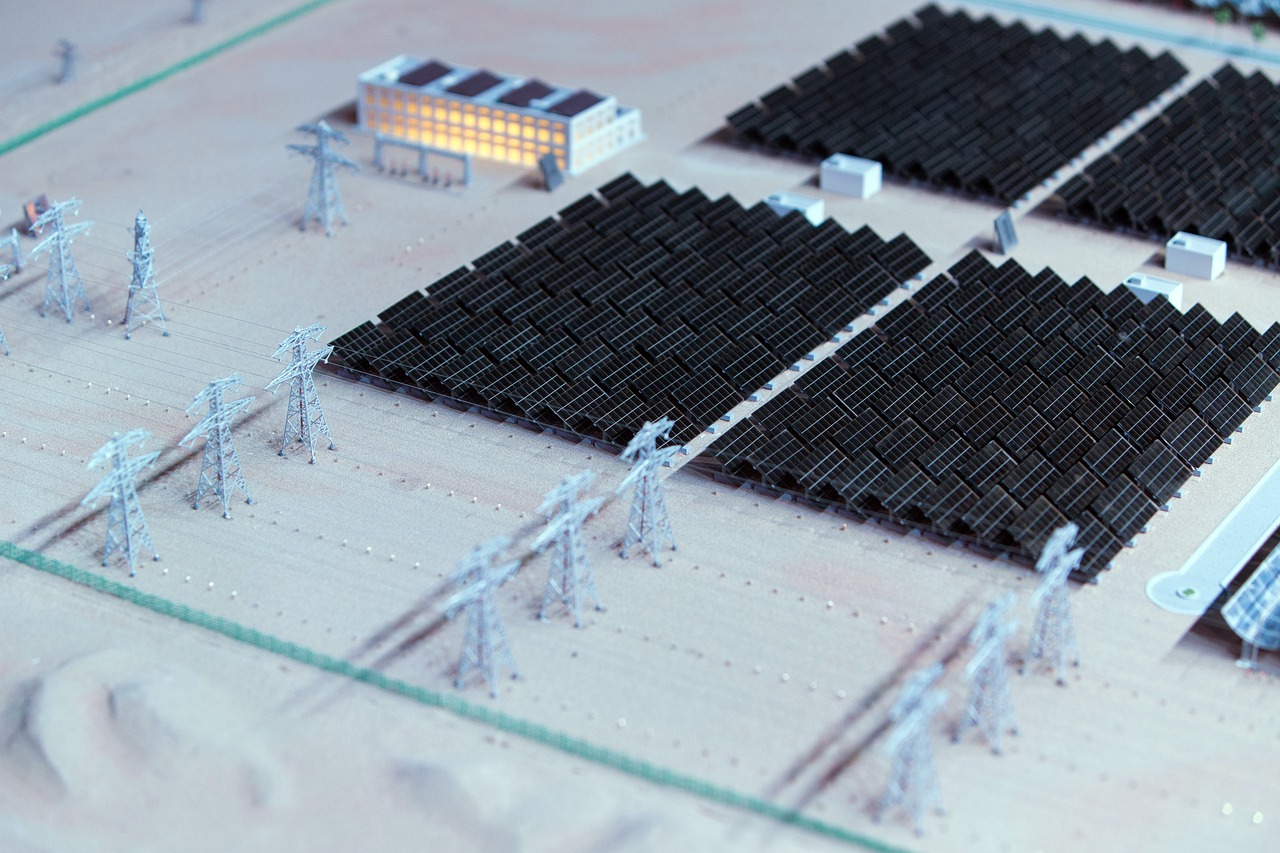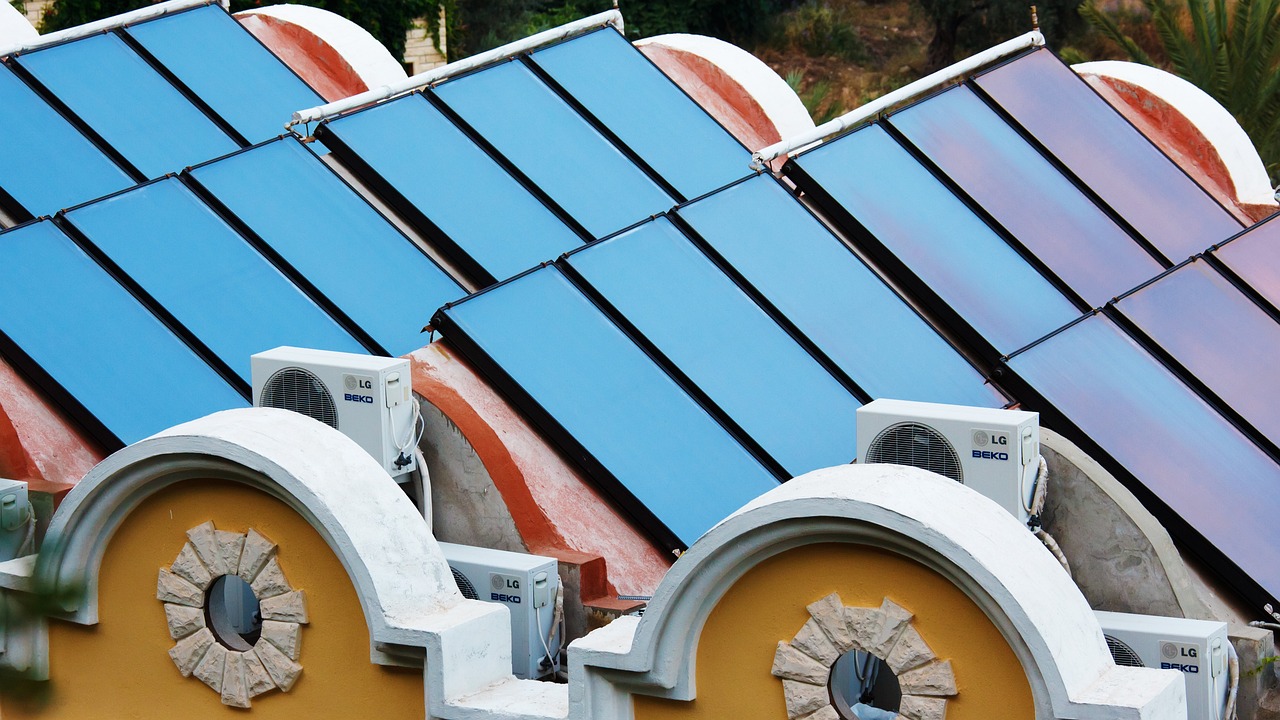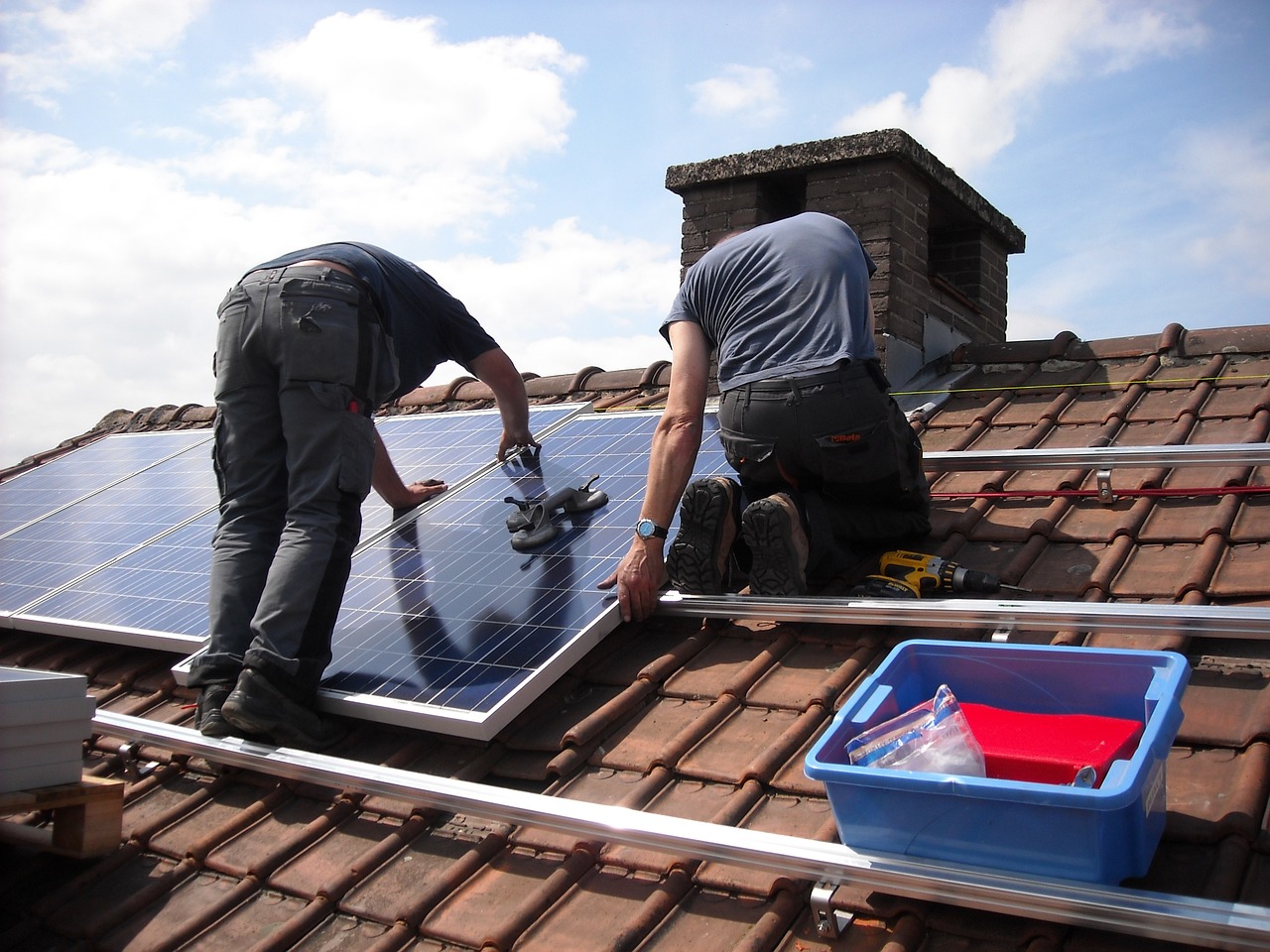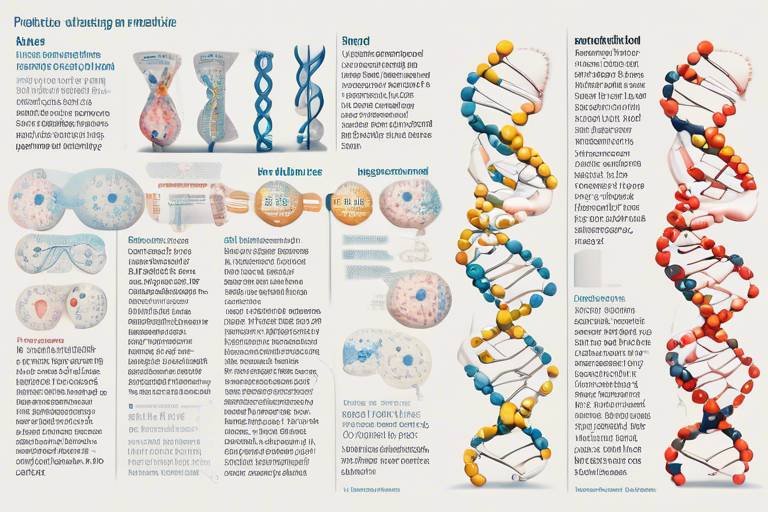Recent Advances in Solar Panel Efficiency
Solar energy has emerged as one of the most promising renewable energy sources, and the quest for improved solar panel efficiency has never been more critical. With the world increasingly turning to sustainable energy solutions, the latest innovations in solar technology are paving the way for a greener future. From cutting-edge materials to advanced manufacturing techniques, these developments are not just enhancing the efficiency of solar panels but are also making them more accessible and affordable for everyone. Imagine a world where your home could be powered by the sun, significantly reducing your electricity bills and your carbon footprint. Sounds appealing, right? Let’s dive into the exciting advancements that are shaping the future of solar energy.
Recent breakthroughs in materials science have led to the creation of photovoltaic cells that are not only more efficient but also more durable. Traditional silicon-based solar panels have served us well, but the emergence of new materials is changing the game. These innovative materials are designed to enhance energy conversion rates, allowing more sunlight to be transformed into usable electricity. For instance, materials like cadmium telluride and copper indium gallium selenide are gaining traction for their ability to capture a wider spectrum of sunlight, maximizing energy production.
One of the most exciting fields revolutionizing solar panels is nanotechnology. By manipulating materials at the nanoscale, scientists are improving light absorption and minimizing energy loss. This means that solar panels can produce more electricity even in low-light conditions. The incorporation of nanostructures into solar cells enhances their overall performance, leading to higher efficiency rates. But what exactly does this entail? Let’s explore some specific advancements.
Quantum dots are tiny semiconductor particles that have the potential to significantly boost solar cell efficiency. These minuscule particles can absorb light more effectively than traditional materials, enabling solar cells to harness energy from a broader spectrum of sunlight. Imagine being able to capture energy from the early morning sun and the late evening glow—quantum dots make this possible. Their unique properties allow for better light absorption and utilization, which translates to higher energy output.
Utilizing quantum dots in solar technology offers several compelling benefits:
- Increased Efficiency: Quantum dots can enhance the energy conversion efficiency of solar cells.
- Flexibility in Design: They allow for innovative designs that can be integrated into various surfaces.
- Potential Cost Reductions: As manufacturing techniques improve, the cost of producing quantum dot-based solar panels may decrease.
Despite their advantages, integrating quantum dots into commercial solar panels isn't without challenges. Issues such as scalability and stability under real-world conditions need to be addressed. Researchers are actively working on these challenges, aiming to ensure that quantum dot technology can be reliably used in everyday solar applications.
Another exciting development is the rise of perovskite solar cells. These cells are gaining attention due to their remarkable efficiency and lower production costs compared to traditional silicon-based panels. With a unique crystal structure, perovskite materials can absorb sunlight more effectively, leading to impressive conversion rates. Their affordability and efficiency make them a promising alternative, particularly for emerging markets where cost is a significant barrier to solar adoption.
Advancements in manufacturing processes are also playing a vital role in enhancing solar panel efficiency. Modern techniques not only lower production costs but also improve the overall quality of solar panels. For example, the rise of 3D printing technology is enabling manufacturers to create customized solar panel designs while minimizing material waste. This innovation not only boosts efficiency but also aligns with sustainability goals.
3D printing is transforming how solar panels are produced. By allowing for customized designs, this technology can lead to panels that are more efficient and tailored to specific environments. Imagine a solar panel designed specifically for your roof’s angle and sunlight exposure—this is now possible thanks to 3D printing.
The introduction of automation in solar panel manufacturing is another game-changer. Automated processes enhance precision and efficiency, resulting in higher-quality products and reduced production times. With less human error and more consistent quality, automated manufacturing is setting new standards for the solar industry.
To truly maximize the efficiency of solar panels, integrating advanced energy storage solutions is crucial. This is especially important during non-sunny periods when energy demand remains high. By combining innovative battery technologies with solar systems, homeowners can store excess energy generated during the day for use at night or during cloudy weather.
Innovative battery technologies are evolving to work seamlessly with solar systems, providing efficient energy storage and enhancing overall system performance. These advancements ensure that solar energy can be used whenever it’s needed, making solar power a more reliable option for consumers.
Lastly, smart grid technologies are enabling better management of solar energy distribution. By improving efficiency and reliability in energy consumption and storage, smart grids ensure that solar energy can be effectively utilized, making it a cornerstone of modern energy infrastructure.
Q1: What are the main benefits of recent advancements in solar panel technology?
A1: The main benefits include increased efficiency, lower production costs, and improved energy storage solutions, making solar energy more accessible and reliable.
Q2: How do quantum dots enhance solar panel efficiency?
A2: Quantum dots enhance efficiency by allowing solar cells to absorb a broader spectrum of sunlight, leading to higher energy output.
Q3: What challenges do perovskite solar cells face?
A3: Perovskite solar cells face challenges related to stability and scalability, which researchers are actively working to overcome.

Innovative Materials
Recent developments in materials science have sparked a revolution in the world of solar energy, leading to the creation of more efficient photovoltaic cells. These advancements not only enhance energy conversion rates but also significantly improve the durability of solar panels. Imagine harnessing the sun's energy with materials that are not only lighter but also more resilient to environmental stressors. This is not just a dream—it's becoming a reality!
One of the most exciting breakthroughs in solar technology is the use of new materials that can absorb sunlight more effectively. Traditional silicon-based solar panels have served us well, but they come with limitations. Enter innovative materials like perovskites and organic photovoltaics. These materials have shown incredible potential in boosting efficiency levels, making them a game-changer in the renewable energy sector.
To give you an idea of the impact of these materials, consider the following table that compares the efficiency of traditional silicon panels with newer alternatives:
| Type of Solar Panel | Average Efficiency (%) | Durability (Years) |
|---|---|---|
| Traditional Silicon | 15-22 | 25-30 |
| Perovskite | 20-25 | 10-15 (under development) |
| Organic Photovoltaics | 10-15 | 5-10 (improving) |
As you can see, while traditional silicon panels have been reliable, the new materials are pushing the boundaries of what we thought was possible. Perovskite solar cells, for example, are not only achieving higher efficiency rates but are also cheaper to produce. This combination of efficiency and cost-effectiveness could lead to a significant decrease in the price of solar energy, making it more accessible to everyone.
However, it's not all sunshine and rainbows. While these innovative materials show great promise, there are still challenges to overcome. For instance, the stability of perovskite solar cells under real-world conditions is still being evaluated. Researchers are working tirelessly to enhance their longevity and performance, ensuring they can withstand the test of time just like their silicon counterparts.
Moreover, the flexibility offered by organic photovoltaics opens up a world of possibilities. Imagine solar panels that can be integrated into building materials, such as windows and roofs, without compromising aesthetics. This could lead to a future where solar energy becomes a seamless part of our urban landscapes. The potential for design innovation in solar technology is as exciting as the energy savings it promises.
In summary, the advancements in innovative materials are paving the way for a brighter, more sustainable future. With ongoing research and development, we can expect to see solar panels that are not only more efficient but also more durable and versatile. As we continue to explore these exciting frontiers, the dream of harnessing the sun's energy in a cost-effective and efficient manner is becoming increasingly tangible.

Nanotechnology in Solar Cells
Nanotechnology is truly a game-changer in the realm of solar energy. By manipulating materials at the atomic and molecular levels, researchers are unlocking new potentials that were previously unimaginable. Imagine trying to catch sunlight with a net made of tiny, invisible threads—that's essentially what nanotechnology does for solar cells. It enhances their ability to absorb light and convert it into energy, resulting in a significant boost in efficiency.
One of the most exciting aspects of nanotechnology in solar cells is its ability to reduce energy loss. Traditional solar panels often struggle with issues like reflection and suboptimal light absorption. However, with the integration of nanostructured materials, these challenges can be mitigated. For instance, when light hits a solar cell, a portion of it is reflected away, but nanotechnology can help create surfaces that trap more light, allowing for better energy conversion. This means that more sunlight translates into more electricity, which is a win-win for both consumers and the environment.
At the forefront of nanotechnology in solar cells are quantum dots. These tiny semiconductor particles are not just small in size; they are mighty in their ability to enhance solar cell performance. By enabling better light absorption, quantum dots allow solar panels to utilize a broader spectrum of sunlight, including those wavelengths that traditional silicon cells might miss. This innovative approach can lead to efficiency rates that are significantly higher than what we currently see.
Utilizing quantum dots in solar technology offers a myriad of advantages:
- Increased Efficiency: Quantum dots can improve the overall energy conversion rates of solar panels, allowing them to generate more power from the same amount of sunlight.
- Flexibility in Design: The unique properties of quantum dots enable the creation of flexible solar panels, opening up new possibilities for integration into various surfaces.
- Potential Cost Reductions: As manufacturing processes improve, the costs associated with producing quantum dot-enhanced solar panels may decrease, making solar energy more accessible to everyone.
Despite the promising advantages, the integration of quantum dots into commercial solar panels is not without its challenges. One major hurdle is scalability. While small-scale experiments may yield fantastic results, scaling up production to meet market demands remains a complex issue. Additionally, the stability of quantum dots under real-world conditions poses another challenge. Researchers are working tirelessly to ensure that these innovative materials can withstand environmental factors over time without degrading in performance.
In conclusion, nanotechnology, particularly through the use of quantum dots, is paving the way for a new era of solar energy. By enhancing light absorption and reducing energy loss, these advancements not only improve efficiency but also contribute to a more sustainable future. As we continue to explore and overcome the challenges associated with these technologies, the potential for solar energy to become a dominant power source grows ever closer.
Q1: What is nanotechnology in solar cells?
Nanotechnology in solar cells involves manipulating materials at the nanoscale to improve light absorption and reduce energy loss, enhancing the efficiency of solar panels.
Q2: How do quantum dots improve solar cell efficiency?
Quantum dots improve solar cell efficiency by enabling better light absorption across a broader spectrum, allowing solar panels to generate more electricity from sunlight.
Q3: What are the challenges of using quantum dots in solar panels?
The main challenges include scalability for mass production and ensuring stability under real-world conditions to maintain performance over time.

Quantum Dots
Quantum dots are tiny semiconductor particles, often just a few nanometers in size, that have taken the solar energy world by storm. Imagine these minute particles as the superheroes of solar technology, capable of significantly enhancing solar cell efficiency. They work their magic by enabling better light absorption and utilizing a broader spectrum of sunlight, which means they can capture more energy than traditional materials. This is not just a minor upgrade; it's akin to switching from a flickering candle to a powerful LED light in terms of energy output.
One of the most exciting aspects of quantum dots is their unique optical properties. They can be engineered to absorb specific wavelengths of light, which allows for a more efficient conversion of sunlight into electricity. This flexibility is crucial because sunlight is not just one color; it’s a spectrum that includes various wavelengths. By optimizing the quantum dots to target different parts of this spectrum, we can dramatically increase the amount of energy harvested from the sun. It's like having a multi-tool that can adapt to any situation, making it incredibly versatile.
However, the advantages of quantum dots don't stop there. They also offer flexibility in design, which means manufacturers can create solar panels that are not only more efficient but also aesthetically pleasing and adaptable to various applications. For instance, quantum dot technology can be integrated into building materials, allowing windows to generate energy without compromising on design. This opens up a world of possibilities for urban environments where space is limited and aesthetics matter.
Despite the numerous benefits, integrating quantum dots into commercial solar panels isn't without its challenges. The scalability of production remains a significant hurdle. While creating small batches of quantum dots in a lab setting is feasible, ramping up to mass production while maintaining quality and performance is a complex task. Furthermore, stability under real-world conditions poses another challenge. Quantum dots need to withstand various environmental factors without degrading, which is essential for long-term performance and reliability.
To summarize, quantum dots represent a groundbreaking advancement in solar technology, holding the potential to redefine how we harness solar energy. Their ability to enhance efficiency, improve design flexibility, and potentially lower manufacturing costs makes them a promising avenue for future research and development. However, as we venture further into this exciting realm, addressing the challenges of scalability and stability will be crucial in unlocking their full potential in commercial applications.
- What are quantum dots? Quantum dots are tiny semiconductor particles that can improve solar cell efficiency by enhancing light absorption.
- How do quantum dots work? They can be engineered to absorb specific wavelengths of light, allowing for better energy conversion from sunlight.
- What are the advantages of using quantum dots in solar panels? They increase efficiency, allow for flexible designs, and can potentially reduce manufacturing costs.
- What challenges do quantum dots face in commercial use? Scalability in production and stability under real-world conditions are significant hurdles that need to be addressed.

Advantages of Quantum Dots
Quantum dots are not just a fascinating topic in the realm of nanotechnology; they represent a significant leap forward in the efficiency of solar panels. One of the most compelling advantages of using quantum dots is their ability to enhance light absorption. Unlike traditional solar cells that can only absorb a limited spectrum of sunlight, quantum dots can be engineered to absorb a broader range of wavelengths. This means that they can capture more energy from the sun, leading to higher overall efficiency rates.
Moreover, the flexibility in design that quantum dots offer is another game changer. Traditional solar panels are often rigid and bulky, which can limit their application in various environments. However, with quantum dots, manufacturers can create flexible solar cells that can be integrated into a variety of surfaces, from building materials to clothing. This opens up a world of possibilities for solar energy utilization, making it more accessible in urban settings where space is at a premium.
Additionally, quantum dots can potentially lead to cost reductions in manufacturing. Since they can be produced using less material and can be synthesized at relatively low temperatures, the overall production costs of solar panels can decrease. This not only makes solar energy more affordable for consumers but also encourages wider adoption, which is crucial for a sustainable future.
To summarize, the advantages of quantum dots in solar technology include:
- Increased Efficiency: Enhanced light absorption leads to better energy conversion.
- Flexibility in Design: Can be integrated into various surfaces and applications.
- Cost-Effective Manufacturing: Reduced material usage and lower production temperatures.
While the benefits are clear, it's essential to keep in mind that the integration of quantum dots into commercial solar panels is still an evolving field. However, the potential they hold is undeniably exciting, paving the way for a future where solar energy can be harnessed more effectively and efficiently.

Challenges in Implementation
While the integration of quantum dots and other advanced materials into solar panel technology brings exciting prospects, it also presents a set of formidable challenges that must be addressed. One of the primary hurdles is scalability. Although quantum dots can enhance efficiency at a laboratory scale, producing them in large quantities for commercial use remains a significant obstacle. The process must not only be efficient but also cost-effective to make it viable for widespread adoption.
Moreover, stability is another critical concern. Quantum dots can degrade when exposed to environmental factors such as moisture, heat, and UV radiation. This raises questions about their long-term performance and reliability in real-world applications. Manufacturers need to develop protective coatings or alternative compositions that can withstand these conditions without compromising efficiency.
Additionally, the cost of production is a crucial factor. While the initial investment in research and development may yield promising results, the transition from laboratory innovations to full-scale manufacturing can be financially daunting. Companies must find ways to reduce production costs while maintaining high-quality standards. This often involves extensive testing and refinement of the manufacturing processes, which can be time-consuming.
Another challenge lies in the regulatory landscape. As new materials and technologies emerge, they must comply with existing safety and environmental regulations. This compliance can slow down the adoption of quantum dots in commercial solar panels, as companies navigate the complex landscape of regulatory approvals.
Finally, there is a need for consumer education. Many potential users may be unaware of the benefits of these advanced solar technologies or may have misconceptions about their efficacy and safety. Effective marketing and educational initiatives are essential to inform consumers and build trust in these innovative solutions.
In summary, while the potential of quantum dots and similar technologies is immense, overcoming these challenges is crucial for their successful implementation in the solar energy market. Addressing scalability, stability, cost, regulatory compliance, and consumer awareness will pave the way for a more sustainable and efficient energy future.
- What are quantum dots? Quantum dots are tiny semiconductor particles that can improve the efficiency of solar cells by enhancing light absorption.
- Why are quantum dots considered an innovation in solar technology? They allow for better utilization of a broader spectrum of sunlight, leading to higher energy conversion rates.
- What challenges do quantum dots face in solar panel production? Key challenges include scalability, stability under environmental conditions, production costs, regulatory compliance, and consumer education.
- How can manufacturers address the challenges of quantum dots? By developing protective coatings, optimizing production processes, and engaging in consumer education and outreach.

Perovskite Solar Cells
Perovskite solar cells are making waves in the renewable energy sector, and for good reason! These innovative cells, named after the mineral perovskite that shares their crystal structure, have shown remarkable potential in terms of efficiency and cost-effectiveness. Imagine a solar panel that could generate more energy at a lower production cost—this is precisely what perovskite technology aims to achieve. In recent years, the efficiency of perovskite solar cells has skyrocketed, with some achieving over 25% efficiency in laboratory settings. This is a significant leap compared to traditional silicon-based panels, which typically hover around 15-22% efficiency.
What sets perovskite solar cells apart is their unique composition. These cells can be made from a variety of materials, including organic compounds and metals, which allows for flexibility in design and application. This adaptability means that perovskite cells can be manufactured using simpler processes, reducing the energy and resources required for production. Additionally, their lightweight and flexible nature opens the door for new applications, such as integration into building materials or portable solar solutions.
However, it's not all sunshine and rainbows. Despite their advantages, perovskite solar cells face challenges that need to be addressed before they can dominate the market. One of the primary concerns is their long-term stability. While they perform exceptionally well in controlled environments, real-world conditions—such as exposure to moisture and UV light—can degrade their performance over time. Researchers are actively working on encapsulation methods to protect these cells and extend their lifespan.
Moreover, the scalability of production remains a hot topic. As demand for renewable energy grows, the ability to mass-produce perovskite cells efficiently is crucial. Currently, the manufacturing processes are still being refined, but the potential for lower costs and higher efficiency makes this an exciting area of research. In fact, many experts believe that with continued advancements, perovskite solar cells could become a mainstream option in the next decade.
In summary, perovskite solar cells represent a promising frontier in solar technology. Their combination of high efficiency, low production costs, and versatility could transform the way we harness solar energy. As researchers continue to tackle the challenges of stability and scalability, the future for perovskite solar cells looks bright—quite literally!
- What are perovskite solar cells made of?
Perovskite solar cells can be made from a variety of materials, including organic compounds and inorganic materials like lead or tin. - How efficient are perovskite solar cells?
In laboratory conditions, perovskite solar cells have achieved efficiencies exceeding 25%, which is higher than traditional silicon-based cells. - Are perovskite solar cells durable?
While they show high efficiency, perovskite solar cells can face challenges with long-term stability under real-world conditions, but ongoing research aims to improve their durability. - What are the potential applications of perovskite solar cells?
Due to their flexibility and lightweight nature, perovskite solar cells can be integrated into various applications, including building materials and portable solar devices.

Improved Manufacturing Techniques
The world of solar panel manufacturing is undergoing a remarkable transformation. Thanks to recent advancements, the production processes are becoming more efficient, cost-effective, and environmentally friendly. One of the most exciting developments is the shift towards automation and advanced manufacturing techniques, which are not only improving the quality of solar panels but also significantly reducing production times. Imagine a factory where robots work alongside humans, streamlining the assembly of solar panels, ensuring that every component is placed with precision. This is not science fiction; it is the reality of modern solar manufacturing.
One of the key innovations in this field is the implementation of 3D printing technology. This method allows manufacturers to create customized solar panel designs that can cater to specific energy needs and spatial constraints. With 3D printing, the possibilities are endless. For instance, solar panels can be designed to fit the unique contours of a building’s roof, maximizing sunlight exposure and energy generation. Additionally, this technology reduces material waste, as it only uses the necessary amount of materials required for production. This not only cuts costs but also contributes to a more sustainable manufacturing process.
Moreover, the integration of automation in production lines is enhancing the overall efficiency of solar panel manufacturing. Automated systems can operate continuously, ensuring that production does not halt for breaks, which is a common issue in traditional manufacturing settings. These systems also improve quality control, as they can detect defects in real-time, allowing for immediate corrections. This level of precision is crucial, given that even minor flaws in solar panels can lead to significant losses in energy efficiency.
Let's take a closer look at some of the benefits of these improved manufacturing techniques:
| Benefit | Description |
|---|---|
| Cost Reduction | Lower production costs due to reduced material waste and efficient labor use. |
| Enhanced Efficiency | Faster production times and improved product quality through automation. |
| Sustainability | More eco-friendly manufacturing processes that minimize environmental impact. |
| Customization | Ability to create tailored solar panel designs that meet specific customer needs. |
As we move forward, the focus on improved manufacturing techniques in solar panel production will be crucial. With the demand for renewable energy sources on the rise, these advancements not only promise to make solar energy more accessible but also pave the way for a sustainable future. The combination of automation and innovative manufacturing processes is a game-changer, making it possible to produce high-quality solar panels at a lower cost, ultimately benefiting consumers and the environment alike.
- What are the main benefits of improved manufacturing techniques for solar panels? Improved manufacturing techniques lead to cost reductions, enhanced efficiency, sustainability, and customization options for solar panels.
- How does 3D printing impact solar panel production? 3D printing allows for customized designs, reduces material waste, and enhances the sustainability of the manufacturing process.
- What role does automation play in solar panel manufacturing? Automation increases production speed, improves quality control, and reduces the likelihood of human error in the manufacturing process.
- Why is sustainability important in solar panel manufacturing? Sustainable manufacturing practices minimize environmental impact, contribute to energy efficiency, and support the overall goal of renewable energy adoption.

3D Printing Technology
3D printing technology is not just a trend; it's a game changer in the solar panel industry. Imagine being able to produce solar panels with intricate designs that optimize sunlight absorption while minimizing material waste. That's the power of 3D printing! This innovative manufacturing process allows for the creation of customized solar panels tailored to specific environments and energy needs. Unlike traditional manufacturing methods that often involve cutting and shaping materials, 3D printing builds panels layer by layer, which significantly reduces waste. This is not just good for the planet; it also means lower production costs.
One of the most exciting aspects of 3D printing in solar technology is its potential for flexibility and creativity. Engineers can experiment with various designs and materials to find the most efficient configurations. For instance, complex geometries that were previously impossible to create can now be realized, allowing for panels that capture sunlight more effectively. Furthermore, 3D printing can facilitate the production of lightweight solar panels, which are easier to install and transport, making them ideal for a range of applications from residential rooftops to large-scale solar farms.
However, the journey of integrating 3D printing into solar panel production is not without its challenges. The technology is still evolving, and there are concerns regarding the durability and longevity of 3D printed materials when exposed to harsh environmental conditions. To address these issues, ongoing research is focused on developing new materials specifically designed for 3D printing that can withstand the rigors of outdoor use.
In summary, 3D printing technology holds immense promise for the future of solar energy. It not only enhances the efficiency and sustainability of solar panel production but also opens the door for innovative designs that can revolutionize how we harness solar energy. As this technology continues to advance, we can expect to see even more exciting developments in the realm of renewable energy.

Automation in Production
In the fast-evolving world of solar panel manufacturing, automation is emerging as a game-changer, streamlining processes and enhancing productivity. Imagine a factory where machines work in perfect harmony, executing tasks with precision that humans simply cannot match. This level of efficiency not only boosts the quality of solar panels but also significantly reduces production times, allowing companies to meet the ever-growing demand for renewable energy solutions.
One of the most significant benefits of automation in solar panel production is the ability to maintain consistency and quality. Traditional manufacturing processes can be prone to human error, leading to variations in product quality. However, with automated systems, each panel is produced with the same high standards, ensuring that every unit meets the required specifications. This consistency is crucial in the solar industry, where even minor defects can lead to substantial energy losses over time.
Moreover, automation allows for the implementation of advanced technologies such as machine learning and artificial intelligence. These technologies can analyze production data in real-time, identifying inefficiencies and suggesting improvements. For instance, if a particular machine is underperforming, the system can alert operators to investigate and rectify the issue promptly. This proactive approach minimizes downtime and maximizes output.
To illustrate the impact of automation, consider the following table that compares traditional manufacturing methods with automated processes in terms of efficiency, cost, and quality:
| Aspect | Traditional Manufacturing | Automated Manufacturing |
|---|---|---|
| Production Speed | Moderate | High |
| Labor Costs | High | Lower |
| Quality Consistency | Variable | Consistent |
| Flexibility in Design | Limited | High |
As we delve deeper into the automation landscape, it's essential to recognize the potential challenges that come with it. While automation can lead to significant advancements, it also requires substantial initial investments in technology and training. Companies must navigate the complexities of integrating new systems into existing workflows, which can be daunting. However, the long-term benefits often outweigh the initial hurdles, making it a worthwhile endeavor.
In conclusion, the role of automation in solar panel production is pivotal. By enhancing efficiency, improving quality, and reducing costs, automation not only helps manufacturers keep pace with demand but also contributes to the broader goal of sustainable energy. As technology continues to advance, we can expect even more innovative solutions that will propel the solar industry forward, making renewable energy accessible to all.
- What is the role of automation in solar panel manufacturing? Automation streamlines production processes, enhances quality, and reduces labor costs, leading to more efficient manufacturing.
- Are there any challenges associated with automating solar panel production? Yes, challenges include initial investment costs and the complexity of integrating new technologies into existing systems.
- How does automation improve the quality of solar panels? Automated processes ensure consistency in production, minimizing human error and defects in the final product.

Energy Storage Solutions
The integration of advanced energy storage solutions with solar panels is crucial for maximizing efficiency and ensuring a reliable power supply, especially during non-sunny periods. Imagine this: you’ve invested in a state-of-the-art solar panel system that generates a surplus of energy during the day. But what happens when the sun sets? This is where energy storage comes into play, acting like a trusty battery that holds onto that precious energy for use when you need it most. By incorporating sophisticated battery systems, homeowners and businesses can harness the full potential of their solar energy production, leading to significant savings on energy bills and a reduced carbon footprint.
Innovative battery technologies are evolving to work seamlessly with solar systems, providing efficient energy storage and enhancing overall system performance. For instance, lithium-ion batteries have become the gold standard in energy storage, thanks to their high energy density and long lifespan. They not only store energy generated during the day but also allow users to draw power during peak hours when electricity rates are higher. This capability transforms solar energy from a mere daytime resource into a reliable energy source around the clock.
Moreover, the development of flow batteries and solid-state batteries is paving the way for even more efficient energy storage solutions. Flow batteries, for example, offer the advantage of scalability and long discharge times, making them ideal for larger solar installations. On the other hand, solid-state batteries promise greater safety and energy density, which could revolutionize the way we store solar energy in the near future.
Another exciting aspect of energy storage is the role of smart grid technologies. These advanced systems enable better management of solar energy distribution, improving efficiency and reliability in energy consumption and storage. With smart grids, energy can be distributed more effectively, allowing for real-time adjustments based on demand and supply. It's akin to having a smart assistant that knows exactly when to save energy and when to release it, optimizing your energy usage without you having to lift a finger.
In summary, the marriage of solar panels with cutting-edge energy storage solutions is not just a trend; it's a necessity for a sustainable future. As technology continues to advance, we can expect even more innovative solutions that will make solar energy more accessible and efficient. This synergy between solar and storage is paving the way for a cleaner, greener planet, and the future looks bright!
- What are the benefits of integrating energy storage with solar panels?
Integrating energy storage with solar panels allows users to store excess energy generated during the day for use at night or during cloudy days, leading to higher efficiency and reduced energy costs. - What types of batteries are commonly used for solar energy storage?
The most commonly used batteries for solar energy storage are lithium-ion batteries, flow batteries, and solid-state batteries, each offering unique advantages. - How does a smart grid improve energy storage efficiency?
A smart grid enhances energy storage efficiency by enabling real-time management of energy supply and demand, ensuring optimal distribution and usage of stored solar energy.

Batteries and Solar Systems
In the ever-evolving world of renewable energy, the synergy between batteries and solar systems is becoming increasingly vital. Imagine your solar panels soaking up the sun's rays during the day, converting that sunlight into usable energy. But what happens when the sun sets or on those cloudy days? This is where advanced battery technologies come into play, acting as the bridge that ensures a continuous power supply.
Modern solar energy systems are now being designed to work seamlessly with innovative battery solutions. These batteries store excess energy generated during peak sunlight hours, allowing homeowners and businesses to utilize solar power even when the sun isn't shining. This not only maximizes the efficiency of solar energy systems but also provides a reliable energy source that can significantly reduce reliance on the grid.
One of the most exciting developments in this field is the rise of lithium-ion batteries, which have become the gold standard for energy storage. Their high energy density, long cycle life, and decreasing costs make them an attractive option for solar energy storage. In fact, recent advancements have led to the development of batteries that can store more energy in a smaller footprint, making them even more efficient and user-friendly.
To illustrate the impact of these advancements, consider the following table that compares traditional lead-acid batteries with modern lithium-ion batteries:
| Feature | Lead-Acid Batteries | Lithium-Ion Batteries |
|---|---|---|
| Energy Density | Low | High |
| Weight | Heavy | Light |
| Cycle Life | 500-800 cycles | 2000-5000 cycles |
| Cost | Lower initial cost | Higher initial cost but lower total cost of ownership |
As you can see, the advantages of lithium-ion batteries are clear. They not only offer better performance but also a longer lifespan, which ultimately translates to cost savings over time. However, it's essential to consider the environmental impact of battery production and disposal, which has led to ongoing research into more sustainable battery technologies.
Moreover, the integration of batteries into solar systems is not just about storing energy; it’s about creating a smart energy ecosystem. With the advent of smart home technology, these batteries can communicate with solar panels to optimize energy use. For instance, during high energy production periods, the system can prioritize charging the battery, while during lower production times, it can draw energy directly from the battery. This dynamic interaction ensures that energy is used as efficiently as possible, reducing waste and enhancing overall system performance.
In conclusion, the relationship between batteries and solar systems is a game-changer in the renewable energy landscape. As technology continues to advance, we can expect even more efficient and sustainable solutions that empower consumers to harness the full potential of solar energy. The future is bright, and with the right storage solutions, we can ensure that the power of the sun is available whenever we need it.
- What types of batteries are best for solar energy systems?
Lithium-ion batteries are currently the most popular choice due to their high efficiency, longevity, and decreasing costs.
- How long do solar batteries last?
Most lithium-ion batteries can last between 10 to 15 years, depending on usage and maintenance.
- Can I use my solar energy system without batteries?
Yes, but you will only have access to solar energy when the sun is shining unless you are connected to the grid.

Smart Grid Integration
In today's fast-paced world, the demand for energy is ever-increasing, and traditional energy systems are struggling to keep up. This is where comes into play, acting as a bridge between renewable energy sources like solar panels and the existing electrical grid. Imagine a network that not only delivers electricity but also optimizes its usage in real-time, ensuring that energy is consumed efficiently and sustainably. Sounds futuristic, right? Well, it's happening now!
Smart grids leverage advanced technologies, such as IoT devices, machine learning, and big data analytics, to monitor and manage energy flows. This means that when your solar panels generate excess energy, the smart grid can detect this surplus and redirect it where it's needed most, whether that's to your home, local businesses, or even back to the grid. This dynamic management is crucial for maximizing the efficiency of solar energy systems, ensuring that every ray of sunlight is harnessed effectively.
Moreover, smart grids facilitate two-way communication between energy producers and consumers. This interaction allows users to monitor their energy usage in real-time, leading to more informed decisions about energy consumption. For instance, if you know that your solar panels are generating a lot of energy during the day, you might choose to run your dishwasher or charge your electric vehicle at that time, instead of during peak hours when electricity is more expensive. This not only saves you money but also reduces strain on the grid.
One of the most exciting aspects of smart grid integration is the potential for demand response programs. These programs incentivize consumers to adjust their energy usage during peak demand times. For example, during a hot summer day when everyone is cranking up their air conditioning, the smart grid can send a signal to participating users to reduce their consumption temporarily, helping to prevent blackouts and ensuring a stable energy supply. It's a win-win situation for both the environment and the economy.
However, the transition to a smart grid isn't without its challenges. Issues such as cybersecurity, data privacy, and the need for substantial infrastructure upgrades can pose significant hurdles. Yet, the benefits of integrating smart grid technology with solar energy systems far outweigh these challenges. As we continue to innovate and adapt, the future of energy will be brighter, cleaner, and more efficient than ever.
To summarize, smart grid integration is a game-changer for the solar energy landscape, enabling better management of energy distribution, enhancing efficiency, and paving the way for a more sustainable energy future. It’s not just about producing energy; it’s about using it wisely and responsibly.
- What is a smart grid? A smart grid is an electrical grid that uses digital technology to monitor and manage the transport of electricity from all generation sources to meet the varying electricity demands of end users.
- How does smart grid integration benefit solar energy? It optimizes energy distribution, enhances efficiency, allows for real-time monitoring, and encourages energy conservation through demand response programs.
- What challenges does smart grid integration face? Key challenges include cybersecurity risks, data privacy concerns, and the need for significant infrastructure investments.
Frequently Asked Questions
- What are the latest innovations in solar panel technology?
Recent innovations include the development of more efficient photovoltaic cells, advancements in materials like quantum dots and perovskite solar cells, and improved manufacturing techniques such as 3D printing and automation. These innovations aim to enhance energy conversion rates and reduce production costs.
- How do quantum dots improve solar panel efficiency?
Quantum dots are tiny semiconductor particles that enhance solar cell efficiency by improving light absorption and enabling the utilization of a broader spectrum of sunlight. This results in higher energy conversion rates and better overall performance of solar panels.
- What challenges are associated with using quantum dots in solar technology?
While quantum dots offer significant advantages, there are challenges in their implementation, such as scalability for mass production and stability under varying environmental conditions. Addressing these issues is crucial for their widespread adoption in commercial solar panels.
- Why are perovskite solar cells considered a promising alternative?
Perovskite solar cells are gaining attention due to their high efficiency and low production costs compared to traditional silicon-based solar panels. Their unique structure allows for better light absorption and energy conversion, making them a viable option for the future of solar energy.
- How does 3D printing technology contribute to solar panel production?
3D printing technology allows for customized designs and reduces material waste in solar panel production. This not only improves efficiency but also promotes sustainability, making solar energy solutions more accessible and eco-friendly.
- What role do energy storage solutions play in solar energy systems?
Advanced energy storage solutions are essential for maximizing the efficiency of solar energy systems. They ensure a reliable power supply during non-sunny periods by storing excess energy generated during peak sunlight hours, thus enhancing overall system performance.
- How does smart grid integration improve solar energy management?
Smart grid technologies facilitate better management of solar energy distribution and consumption. By optimizing energy flow and storage, smart grids enhance the reliability and efficiency of solar energy systems, ensuring that energy is used effectively.



















